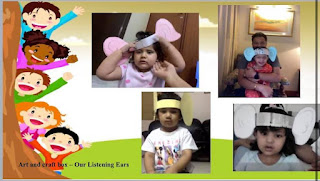Understanding English Pronunciation: A Simple Guide
Learning English is essential in today’s globalized world. It's the most spoken language across continents, with about 1.5 billion people using it. Speaking English opens many doors for your child. You can excel in business, make friends, and travel easily. It’s a valuable skill.
But English isn't just about grammar. You need good pronunciation. It's crucial for people to understand you. A good preschool in Gurgaon emphasizes communication skills in toddlers, highlighting the importance of clear speech early on.
Vowels vs. Consonants
English isn’t phonetic, making pronunciation tricky. First, understand the difference between vowels and consonants that are taught in every preschool school. There are 26 letters in the English alphabet. Five are vowels (A, E, I, O, U), and 21 are consonants. The main difference is how you make the sound.
Vowel sounds are smooth and continuous. Try saying A, E, I, O, U. The sound flows without stopping. Consonant sounds, on the other hand, block the airflow briefly. Try saying “m” or “p.” You’ll notice a short stop in the sound.
Why English Words Are Hard
The challenge with English pronunciation lies in its inconsistency. Sounds can change based on the combination of vowels and consonants. Sometimes, similar words sound different, making learning hard. But a good preschool in Gurgaon explains it clearly to toddlers so that they find it easy to grasp.
For example, “tear” (to cry) and “tear” (to rip) are pronounced differently. Conversely, “stair” and “stare” sound the same despite different spellings.
International Phonetic Alphabet (IPA)
To assist learners, linguists created the International Phonetic Alphabet (IPA). It’s a system with symbols representing sounds. You can find it in dictionaries and language books. Knowing IPA symbols can significantly aid in learning pronunciation. So every preschool school these days, stress on teaching IPA to their students.
Short Vowels
These are quick sounds. Common symbols include:
æ (as in back, had, pass)
ɛ (as in end, every, ever)
ʌ (as in cup, love, flood)
ʊ (as in book, foot, full)
ɒ (as in often, office, squat)
ə (as in mother, action, never)
Long Vowels
These sound like their names. Common symbols include:
i: (as in be, need, feel)
ɜ: (as in her, turn, word)
ɔ: (as in more, also, small)
u: (as in new, too, you)
ɑ: (as in ask, father, bar)
Diphthong Vowels
These are two sounds combined. Common symbols include:
ɪə (as in here, idea, clear)
eə (as in care, share, where)
eɪ (as in day, play, age)
ɔɪ (as in join, boy, voice)
aɪ (as in buy, high, guy)
oʊ (as in home, hold, only)
aʊ (as in house, town, now)
Plosives
These sounds block and release air. Common symbols include:
p (as in happen, play, pay)
b (as in but, best, job)
t (as in take, tell, time)
d (as in day, do, decide)
k (as in can, think, school)
g (as in give, go, agree)
Fricatives
These sounds create friction. Common symbols include:
f (as in from, phone, fact)
v (as in move, value, live)
θ (as in thing, month, thank)
ð (as in with, they, then)
z (as in these, zone, citizen)
ʃ (as in push, show, finish)
ʒ (as in pleasure, vision, version)
h (as in help, who, hello)
Nasals
These sounds use the nose. Common symbols include:
m (as in man, more, come)
n (as in not, know, woman)
ŋ (as in thank, think, song)
Affricates
These sounds start as plosives and end as fricatives. Common symbols include:
ʈʃ (as in church, change, challenge)
dʒ (as in job, join, huge)
Approximants
These sounds are frictionless and vowel-like. Common symbols include:
r (as in carry, very, road)
j (as in unit, argue, during)
w (as in where, wait, we)
l (as in leave, look, people)
Conclusion
Learning English pronunciation is challenging but rewarding. Using this guide by the best preschool in Gurgaon, you can improve your child's skills. Practice regularly and stay patient. Over time, you'll see improvement. Good luck!




Comments
Post a Comment